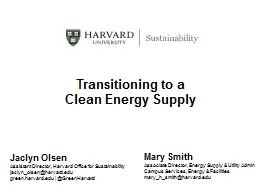

Clean Energy Supply Jaclyn Olsen Assistant Director Harvard Office for Sustainability j aclynolsenharvardedu greenharvardedu GreenHarvard Mary Smith Associate Director Energy Supply amp Utility Admin ID: 577224
Download Presentation The PPT/PDF document "Transitioning to a" is the property of its rightful owner. Permission is granted to download and print the materials on this web site for personal, non-commercial use only, and to display it on your personal computer provided you do not modify the materials and that you retain all copyright notices contained in the materials. By downloading content from our website, you accept the terms of this agreement.
Slide1
Transitioning to a
Clean Energy Supply
Jaclyn OlsenAssistant Director, Harvard Office for Sustainabilityjaclyn_olsen@harvard.edugreen.harvard.edu | @GreenHarvard
Mary Smith
Associate Director, Energy Supply & Utility Admin
Campus Services, Energy & Facilities
mary_h_smith@harvard.eduSlide2Slide3
Confronting Climate Change
Commitment
| University-wide on-site renewable energy studyCommitment | Explore renewable energy purchasing goalSlide4
Energy Supply and Renewables
1 MW of installed solar PV
14% of electricity from renewable sources to meet MA RPS (3% from alternative sources)
Steam Plant fuel switching, equipment upgrades combined with utility efficiencies and demand reduction account for 60% of greenhouse gas reduction to date
Expanded CHP system online in fall 2015Slide5
Complementary Mechanisms
Advisory Group of faculty, students, staff convened by President Faust
Make recommendations to University on use of off-site complementary mechanisms for achieving GHG emissions reduction goal.
C
arbon offsets
O
ff
-site renewable energy,
etc…Slide6
Licensed
Retail SupplierLimited to Harvard entitiesAllows
wholesale purchasesMore control over electric policyPurchasing policyStability, predictability, economically efficient
A
shaped load
Accommodates a variety of
options
Energy Sources
System power
Specific generation sources
Self production
Energy Purchasing StrategySlide7
Largest component of electric mix
Includes all sources of powerMost suppliers offer System PowerMost current market rules based on this
System PowerSlide8
Traditional
RenewableHydroWindSolarOther(All unit contingent–purchase from specific entities)
Demand ResourcesCHPEnergy efficiencySpecific Power SourcesSlide9
Primarily small hydro within New
England2.5% of RPS, currently RECs only
HydroSlide10
Class 1 Renewable (8% of RPS)
Harvard purchases 10% of its energy from Maine wind farm (provides energy +) RECsDEP permits purchase of RECs + energy to be used in establishing one’s own emissions labelWind is variableRequires basis paymentsZonal LMPs may differ
Good source of Class 1 RECsWindSlide11
Class 1 RPS component
On-site or Off-site9 On-site solar installationBehind the meterRange from 4 KW to 500 KWSRECS instrumental in installationsHarvard serves most customers on a
microgridIntegrates well with electric supplyCurrently use all the SRECs to meet regulatory requirementsSolarSlide12
Volatility
High priceNeed to keep RECs to reduce emissions
Long-term obligations can be disruptive in the futureEnergy Purchasing ChallengesSlide13
RPS represents 14.28% of the customer loadIntent
was to help support the installation of new, cleaner technologiesClass 1 represents 8% of RPSSREC 1 2014 - 0.948%, 2015 – 2.144%SREC2 2014 – 0.0843%,2015 – 0.3288%Class 2 supports hydro built prior to 19972.5% of load this yearWTE
– 3.5% and limited availabilityAECs – Primarily CHP; 3.5%RPSSlide14
Renewable market is establishedNot yet price
competitiveRPS designed to assist technologies to thrive Perhaps this should be more flexible and represent technologies that need the push to get going (storage)
Conclusion
Goal:
Integrate
renewables into the
market
and make
it the technology of choice.Slide15
@GreenHarvard
green.harvard.edu
Connect with us